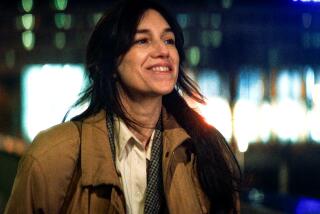Cinema ‘Paradise’
- Share via
Marcel Carne’s 1944 “Children of Paradise” makes its U.S. television premiere this week on cable’s Cinemax. Times film writer Kevin Thomas explains here why this once-neglected film is considered a masterwork.
The passion, the vitality and the grandeur of “Children of Paradise” is so overwhelming it makes one re-evaluate all the other films considered masterpieces. It has the solid construction, the flesh-and-blood characters and wealth of incident and detail of the 19th-Century novel.
With the elusiveness of love as its theme--and also the relationship of life and art (which here become one), it creates its own glittering world of backstage life, peopled with performers who discover themselves the heroes and the villains and the clowns in the tragicomedy of their own lives.
This romantic classic, made under terrible hardships in Occupied France during World War II, was first seen in in its restored, considerably longer version in America in the early 1960s, a time when the New Wave already had made its international impact. At the time, its director, Marcel Carne, was out of favor as perhaps the ultimate symbol of the so-called “cinema of quality” that young critics and filmmakers were rebelling against.
In the years since its restoration, the film has been revived frequently, enabling it to be put in its proper perspective as a remarkable achievement whose brilliance transcends the passage of time and the fickleness of fashion.
Only a work of art could produce an impact of such intensity more than 45 years since its completion. “Children of Paradise” recently was designated by the French Academy of Cinema Arts and Techniques as France’s greatest sound film--even over Jean Renoir’s “Grand Illusion” and “Rules of the Game,” films that routinely make all-time greats lists.
The opening sequence of “Children of Paradise” is breathtaking. As the camera pulls back to reveal the vast, crowded Boulevard of Crime lined with sideshow attractions, it sweeps us into a carnival in the Paris of 1840--the circus acts, the barkers and the pickpockets. As the camera moves down the street it introduces us to the beautiful Garance, billed as the Naked Truth, and some of the men who will enter her life: the young actor Frederick Lemaitre, the talented mime Baptiste and the thief Lacenaire.
We learn about these larger-than-life characters in the traditional way: by watching them develop as the story unfolds (no first-person narration or stream-of-consciousness techniques here).
As omniscient observer, Carne is here primarily to serve his splendid actors, who in turn serve the superb script of Jacques Prevert with its polished, poetic dialogue. Style is subordinate to content, which reverses the majority of the important French films of the past three decades (the most notable exception being the films of Bertrand Tavernier).
The cast is very nearly unforgettable, especially Arletty as Garance with her Mona Lisa smile, and Jean-Louis Barrault, whose sharp features and graceful movement make him a distinctive mime as Baptiste. Pierre Brasseur, with his rich, deep voice and flamboyance, conveys the spirit and warmth of the actor Lemaitre. The many smaller roles are performed with equal perfection.
The making of “Children of Paradise” is a story unto itself. For example, all the sets and costumes were designed by the internationally renowned art director Alexandre Trauner, yet as a Hungarian Jew in Occupied France he had to do all his work in hiding. His monumental achievement was of necessity attributed in the credits to another distinguished designer, Leon Barsacq.
At one point during shooting at the Victorine Studios in Nice, where the immense outdoor Boulevard du Crime set was constructed, filming was halted after the American invasion of Sicily in July and August of 1943; at another point, the set was seriously damaged by a hurricane and had to be rebuilt.
One obstacle Carne could not overcome was getting permission from the Germans to shoot on the Boulevard set at night; as a result, a few essential night scenes had to be shot with miniatures in a Paris studio. Yet “Children of Paradise” stands as a tribute to the indomitability of French art and artists in the face of constant and perilous adversity.
“Dreams and life must be the same or life isn’t worth living,” insists Baptiste the clown. “Children of Paradise” captures those rare moments when they are the same.
“Children of Paradise” airs Monday at 8 p.m., Friday at 9:30 a.m. and on Dec. 24 at 1:30 p.m. on Cinemax.
More to Read
Only good movies
Get the Indie Focus newsletter, Mark Olsen's weekly guide to the world of cinema.
You may occasionally receive promotional content from the Los Angeles Times.










